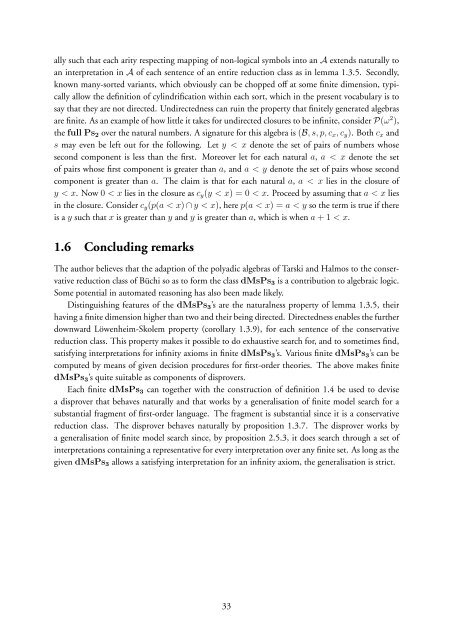On the methods of mechanical non-theorems (latest version)
On the methods of mechanical non-theorems (latest version)
On the methods of mechanical non-theorems (latest version)
Create successful ePaper yourself
Turn your PDF publications into a flip-book with our unique Google optimized e-Paper software.
ally such that each arity respecting mapping <strong>of</strong> <strong>non</strong>-logical symbols into an A extends naturally to<br />
an interpretation in A <strong>of</strong> each sentence <strong>of</strong> an entire reduction class as in lemma 1.3.5. Secondly,<br />
known many-sorted variants, which obviously can be chopped <strong>of</strong>f at some finite dimension, typically<br />
allow <strong>the</strong> definition <strong>of</strong> cylindrification within each sort, which in <strong>the</strong> present vocabulary is to<br />
say that <strong>the</strong>y are not directed. Undirectedness can ruin <strong>the</strong> property that finitely generated algebras<br />
are finite. As an example <strong>of</strong> how little it takes for undirected closures to be infinite, consider P(ω 2 ),<br />
<strong>the</strong> full Ps 2 over <strong>the</strong> natural numbers. A signature for this algebra is (B, s, p, c x , c y ). Both c x and<br />
s may even be left out for <strong>the</strong> following. Let y < x denote <strong>the</strong> set <strong>of</strong> pairs <strong>of</strong> numbers whose<br />
second component is less than <strong>the</strong> first. Moreover let for each natural a, a < x denote <strong>the</strong> set<br />
<strong>of</strong> pairs whose first component is greater than a, and a < y denote <strong>the</strong> set <strong>of</strong> pairs whose second<br />
component is greater than a. The claim is that for each natural a, a < x lies in <strong>the</strong> closure <strong>of</strong><br />
y < x. Now 0 < x lies in <strong>the</strong> closure as c y (y < x) = 0 < x. Proceed by assuming that a < x lies<br />
in <strong>the</strong> closure. Consider c y (p(a < x) ∩ y < x), here p(a < x) = a < y so <strong>the</strong> term is true if <strong>the</strong>re<br />
is a y such that x is greater than y and y is greater than a, which is when a + 1 < x.<br />
1.6 Concluding remarks<br />
The author believes that <strong>the</strong> adaption <strong>of</strong> <strong>the</strong> polyadic algebras <strong>of</strong> Tarski and Halmos to <strong>the</strong> conservative<br />
reduction class <strong>of</strong> Büchi so as to form <strong>the</strong> class dMsPs 3 is a contribution to algebraic logic.<br />
Some potential in automated reasoning has also been made likely.<br />
Distinguishing features <strong>of</strong> <strong>the</strong> dMsPs 3 ’s are <strong>the</strong> naturalness property <strong>of</strong> lemma 1.3.5, <strong>the</strong>ir<br />
having a finite dimension higher than two and <strong>the</strong>ir being directed. Directedness enables <strong>the</strong> fur<strong>the</strong>r<br />
downward Löwenheim-Skolem property (corollary 1.3.9), for each sentence <strong>of</strong> <strong>the</strong> conservative<br />
reduction class. This property makes it possible to do exhaustive search for, and to sometimes find,<br />
satisfying interpretations for infinity axioms in finite dMsPs 3 ’s. Various finite dMsPs 3 ’s can be<br />
computed by means <strong>of</strong> given decision procedures for first-order <strong>the</strong>ories. The above makes finite<br />
dMsPs 3 ’s quite suitable as components <strong>of</strong> disprovers.<br />
Each finite dMsPs 3 can toge<strong>the</strong>r with <strong>the</strong> construction <strong>of</strong> definition 1.4 be used to devise<br />
a disprover that behaves naturally and that works by a generalisation <strong>of</strong> finite model search for a<br />
substantial fragment <strong>of</strong> first-order language. The fragment is substantial since it is a conservative<br />
reduction class. The disprover behaves naturally by proposition 1.3.7. The disprover works by<br />
a generalisation <strong>of</strong> finite model search since, by proposition 2.5.3, it does search through a set <strong>of</strong><br />
interpretations containing a representative for every interpretation over any finite set. As long as <strong>the</strong><br />
given dMsPs 3 allows a satisfying interpretation for an infinity axiom, <strong>the</strong> generalisation is strict.<br />
33
















